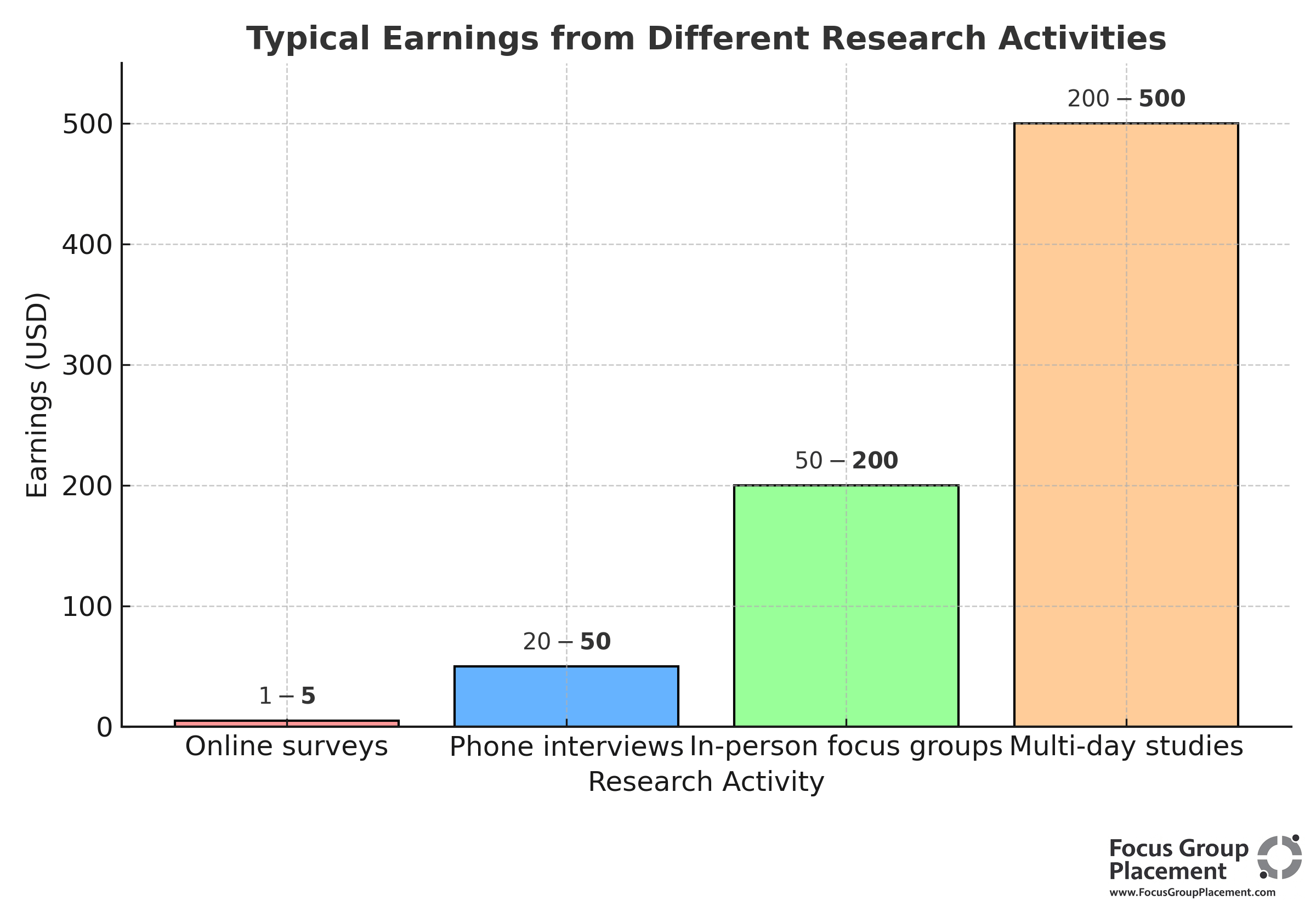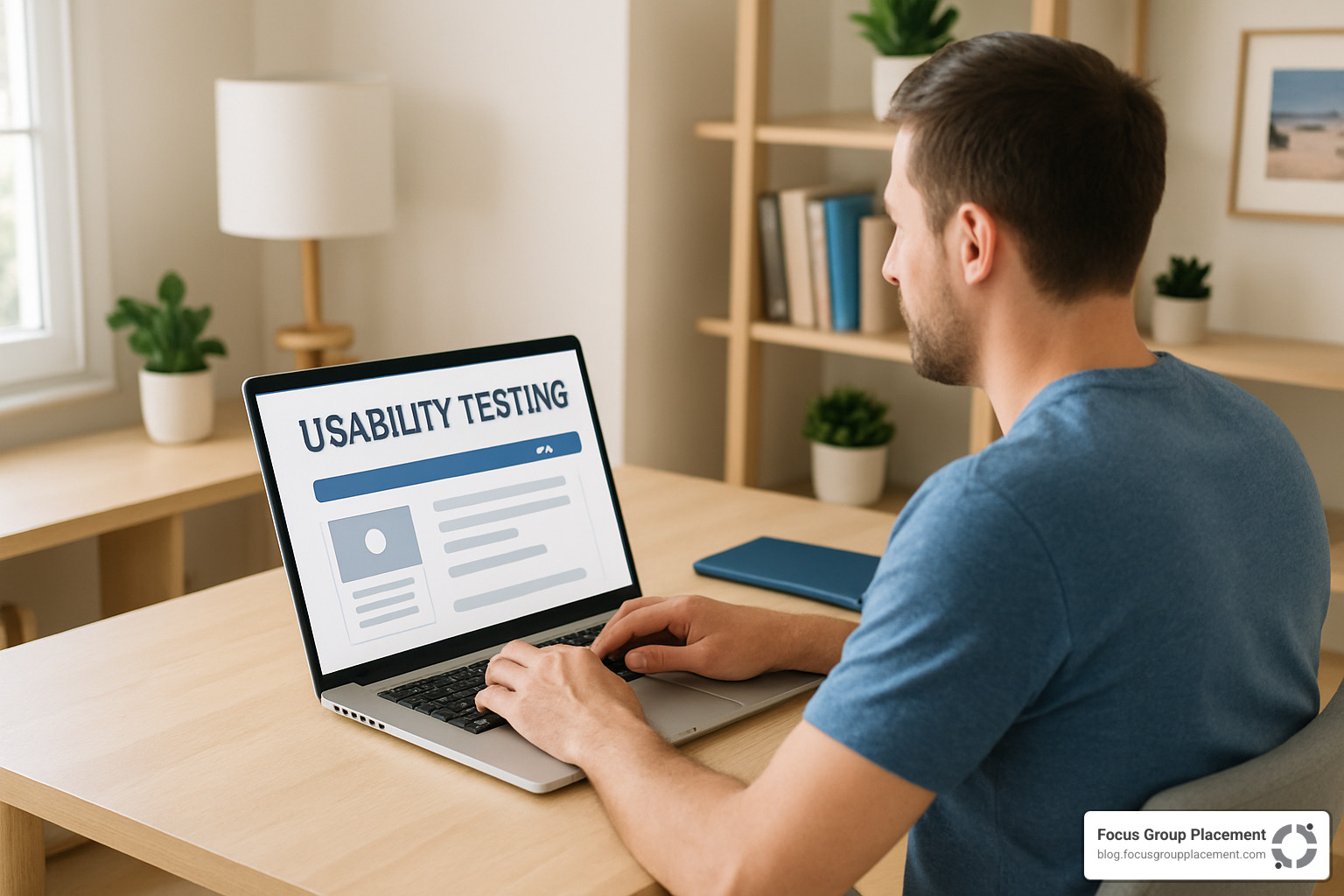Online usability testing jobs are readily available for anyone looking to earn money by providing feedback on websites and apps. Here’s what you need to know:
- Pay Range: $5-50 per test (typically 15-75 minutes)
- Requirements: Computer/smartphone, internet connection, microphone
- Popular Platforms: Many reputable testing platforms available online
- No Cost to Join: All legitimate platforms are free to sign up
- Payment Methods: Most pay via PayPal within 7-14 days of completed tests
Looking for a flexible side hustle you can do from home? Online usability testing jobs offer a legitimate way to earn extra income by simply sharing your thoughts about websites and apps. Companies need real people to test their digital products before launching them to the public, and they’re willing to pay for your honest feedback.
These gigs don’t require special technical skills – just your ability to steer websites or apps while speaking your thoughts aloud. Most tests take between 15-75 minutes to complete, and you can earn anywhere from $5 to $50 per test depending on complexity and duration.
The beauty of usability testing is its flexibility. You decide when and how often you want to work. Tests can be completed from anywhere with a decent internet connection, making them perfect for busy professionals seeking supplemental income without long-term commitments.
According to our research, some testing platforms have paid out more than $500 to individual testers in just a few months, while others have distributed over $100,000 to their testing communities.
My name is Scott Brown, founder of Focus Group Placement, where I’ve spent years connecting people with legitimate online usability testing jobs and other market research opportunities. With over 37,000 research studies facilitated and more than $6 million paid to participants, I understand what makes a reliable side gig in today’s digital economy.

What Is Online Usability Testing?
Ever wondered what happens before a website or app goes public? That’s where online usability testing jobs come in! This research method helps companies see how real people like you interact with their digital products. Your role as a tester is refreshingly simple: complete specific tasks on websites or apps while sharing your honest thoughts about the experience.
The heart of usability testing is what researchers call the “think-aloud” method. Don’t worry—it’s exactly what it sounds like! You simply verbalize your thoughts, reactions, and yes, even frustrations as you steer through a website or app. This real-time commentary provides insights that even the fanciest analytics tools can’t capture—the actual human experience behind all those clicks and taps.
You might be asked to test one of two types of products:
Prototypes are early-stage designs that aren’t fully functional yet. Think of them as digital drafts where your feedback helps shape the final product.
Live websites and apps are existing products that companies want to improve. Your fresh perspective helps them spot issues they’ve become blind to.
Testing sessions typically come in two flavors:
During moderated tests, a friendly researcher guides you through the session in real-time, asking follow-up questions about your experience. It’s like having a conversation about the product.
With unmoderated tests, you follow instructions independently and record your screen and voice as you go. These offer more flexibility since you can complete them on your own schedule.
Some companies also conduct specialized accessibility tests, checking if their websites work properly for people with disabilities who use assistive technologies like screen readers. These tests are particularly valuable for creating more inclusive digital experiences.
Why Companies Pay for Feedback
“Why would anyone pay for my opinion?” It’s a common question, and the answer is simple: your feedback is incredibly valuable.
Companies invest in usability testing because it directly impacts their bottom line. Improving user experience can boost conversion rates by up to 400%—that’s the difference between a struggling business and a thriving one.
Finding problems early through testing is much cheaper than fixing them after launch. One usability issue finded after a product goes live can cost thousands to repair, not to mention the damage to customer trust.
Perhaps most importantly, real user feedback helps companies create products people actually want to use. As one experienced tester puts it: “Your insights help improve products and services for top-tier brands.”
When you participate in online usability testing jobs, you’re not just earning extra cash—you’re helping shape the digital products millions of people use every day. That’s pretty cool for a side gig you can do in your pajamas!
Online Usability Testing Jobs: Step-by-Step Roadmap
Ready to jump into online usability testing jobs? Getting started is simpler than you might think. Here’s the typical journey from signing up to earning your first payment:
First, you’ll create a free account on a testing platform—and yes, legitimate platforms are always free to join. After signing up, you’ll complete your demographic profile with details about your age, occupation, interests, and tech habits. This information helps match you with relevant tests where your perspective matters most.
Most platforms require a practice test before you can access paid opportunities. Think of this as your audition—it verifies your equipment works properly and shows you understand how to provide valuable feedback. Don’t worry if you’re nervous; many testers say the practice run helped them feel confident for real assignments.
Once approved, you’ll gain access to your tester dashboard where new opportunities appear. Check it regularly—the early bird often gets the worm in the testing world! When you see an available test, you’ll typically answer a few screener questions to determine if you’re the right fit for that particular study.
“I make it a habit to check my dashboard every morning while having coffee,” shares one regular tester. “The best opportunities often fill up within hours.”
Your performance matters in this gig. Most platforms use a rating system based on the quality of your feedback, and those with higher ratings receive more testing invitations. Thoughtful, detailed responses are your ticket to consistent work.
| Payment Type |
Typical Range |
Pros |
Cons |
| Fixed-price |
$5-30 per test |
Clear expectations, predictable earnings |
Limited earning potential per test |
| Hourly |
$30-60 per hour |
Better compensation for longer tests |
Fewer opportunities, more competition |
| Bug bounty |
$5-50 per bug |
Unlimited earning potential |
Payment only for accepted bugs |
| Live interviews |
$50-100 per session |
Higher pay rates, direct interaction |
Requires scheduling, more pressure |
Typical Tasks in Online Usability Testing Jobs
During a typical usability test, you’ll step into the shoes of an everyday user while sharing your honest thoughts. You might be asked to steer through a website to find specific information or products—”Find a flight to Miami for next weekend and proceed until the payment page.”
Checkout process testing is particularly valuable to companies. You’ll follow steps to purchase items (without actually completing the transaction) while commenting on what works well and what feels confusing.
First impression tests are quick but crucial. Companies want to know what catches your eye when you land on their homepage and whether their purpose is immediately clear. “What do you think this company does based on the homepage alone?” is a common question.
Bug hunting assignments ask you to report any glitches or problems you encounter while using an app or website. Most tests conclude with a follow-up survey to capture additional thoughts about your experience.
The golden rule of usability testing is simple: speak your thoughts aloud throughout the entire process. As one Trymata tester puts it: “Use the site or app exactly as you would in real life and voice your honest thoughts and frustrations aloud so developers can understand your experience.”

What You Need to Get Started
The beauty of online usability testing jobs is their accessibility—you likely already have everything you need. A computer or smartphone with a stable internet connection (at least 3.0 Mbps upload speed) forms the foundation of your testing setup.
Your device’s built-in microphone will work for most tests, though a headset provides clearer audio and can help you land more opportunities. Some tests require a webcam to capture facial expressions, but many don’t—making this optional equipment for getting started.
You’ll need a PayPal account for receiving payments, as most platforms use this method. Some offer alternatives like Skrill or direct bank transfers, but PayPal remains the industry standard.
Perhaps most importantly, you need a quiet space where you can speak your thoughts without interruptions. Background noise can ruin recordings and potentially disqualify your submissions.
“I turned my walk-in closet into my testing space,” shares one regular tester. “The clothes absorb sound and it’s the quietest spot in my apartment!”
According to UserTesting’s requirements: “You need a Windows, Mac, iOS, or Android device meeting specified OS, RAM, disk space, browser, and battery requirements.” Don’t worry—most modern devices easily qualify, but it’s worth checking the specific requirements for each platform you join.
Finding Legit Remote Testing Gigs
Looking for online usability testing jobs can feel overwhelming with so many options out there. I’ve helped thousands of people find legitimate opportunities, and I’m happy to share the most reliable places to find these flexible gigs.
The digital world is full of companies eager to hear your thoughts on their websites and apps. There are several specialized platforms that connect businesses and everyday testers like you.
Many of these platforms have built impressive communities of testers worldwide. With dozens of studies conducted daily across various platforms, you’ll find regular opportunities to share your feedback and earn rewards.
Some platforms offer a straightforward experience with payments ranging from $5-30 per test. The most reliable ones send payments every weekday morning, so you’re never left wondering when you’ll get paid.
Others stand out by providing testers with multiple invitations daily. Some use bug bounty systems that can be especially lucrative, with top-quality bug findings paying up to $50 each.
The best platforms have impressive track records, having paid out substantial sums to their testing communities. With hundreds of thousands of designs tested on these platforms, they clearly have staying power in the industry.
Market Research Panels
At Focus Group Placement, we specialize in connecting people just like you with various paid research opportunities, including usability testing. Our platform has grown substantially over the years because we prioritize legitimate, well-paying opportunities:
We’ve facilitated more than 37,000 focus groups and studies, resulting in over $6 million paid directly to participants. Our community now includes over 850,000 members who trust us to find them relevant opportunities. While we operate in over 200 cities for in-person research, we also offer nationwide online opportunities that you can complete from the comfort of your home.
Other Sources
Beyond dedicated platforms, keep an eye on freelance marketplaces like Upwork, which occasionally list usability testing contracts. Traditional job boards can also yield opportunities if you search for terms like “usability tester” or “user experience tester.” Some companies even recruit testers directly through social media campaigns when they need fresh perspectives.
One crucial thing to remember: legitimate platforms never charge fees to join. As industry experts plainly state: “Registration is free; anyone asking for payment is a scammer.” This is a golden rule in the testing world.
For more information about current opportunities, you can check our study listings.
Screening Smarter to Land More Online Usability Testing Jobs
The secret to securing a steady flow of online usability testing jobs lies in understanding how the screening process works. I’ve seen what makes successful testers stand out:
- Complete your profile 100%. Testing platforms use your demographic and interest information to match you with relevant tests. The more details you provide, the more likely you’ll be selected for opportunities that fit your background.
- Respond quickly to invitations. When a new test becomes available, it often fills up within minutes. Setting up notifications on your phone or checking your email frequently can help you grab opportunities before they disappear.

- Answer screener questions honestly. It might be tempting to provide answers you think will get you selected, but misrepresenting yourself can get your account flagged or even permanently banned. As one experienced tester wisely advises: “What is a ‘Screener’? A short questionnaire to determine if your profile matches a test; answer honestly to maintain eligibility.”
- Register multiple devices if possible. Being available to test on different platforms (desktop, mobile, tablet) significantly increases your opportunities since many companies need feedback across various devices.
- Be flexible with time zones. If you can make yourself available during business hours in different regions, you’ll receive more invitations. Early mornings or evenings might be prime times to catch tests from companies in other parts of the world.
With these strategies in place, you’ll be well on your way to building a consistent side income through online usability testing jobs.
How Much You Can Earn & How Payments Work
Wondering what your wallet will look like after diving into online usability testing jobs? Let’s talk real numbers.
Your earning potential varies widely based on several factors that influence how much and how often you’ll get paid. Longer, more complex tests typically come with higher payouts, and if you’re in a sought-after demographic (like a healthcare professional or business owner), you might see more opportunities in your inbox.
From our research across the major platforms, here’s what your bank account might expect:
Most standard 15-30 minute tests pay between $5-30, while longer sessions running 45-75 minutes can net you $30-50. If you’re invited to participate in live interviews with researchers (the golden tickets of usability testing), you could earn $50-100 for a single hour of your time. For those with a knack for finding problems, bug bounty payments range from $5-50 per accepted issue you report.
“I was able to make more than $500 in a few months just sharing my thoughts,” shared one participant. While this isn’t quit-your-day-job money, it can certainly cover a few bills or fund your coffee habit.
Payment schedules follow different rhythms depending on the platform:
- Some process payments every 15 days via PayPal
- Others send payments every weekday morning
- Many release funds 7-14 days after test completion
- Some process payments monthly
As an independent contractor, Uncle Sam doesn’t take his cut upfront. You’re responsible for reporting this income on your taxes, as no platforms withhold taxes from your payments.
Worried about your audio quality affecting your acceptance rate? Many platforms offer helpful remote audio setup tips to ensure your recordings are crystal clear.

Maximizing Hourly Rate
While online usability testing jobs won’t replace your full-time income, there are smart ways to boost your earnings.
Set aside dedicated “testing blocks” in your schedule to batch multiple sessions together. This rhythm helps you check for new opportunities and complete several tests efficiently, maximizing your hourly rate.
Maintaining a stellar rating is perhaps your best strategy for increasing earnings. Testers with high-quality feedback get more invitations, plain and simple. Be thorough, articulate, and honest in your assessments.
If you have specialized knowledge in healthcare, finance, or technology, highlight these skills in your profile. Companies often pay premium rates for testers who understand their industry jargon and typical user behaviors.
Whenever possible, jump on live interview opportunities. These real-time sessions with researchers pay significantly more than standard tests and can dramatically boost your monthly earnings.
Many platforms also offer referral bonuses, so telling your friends about your testing gig might put a few extra dollars in your pocket too.
Many experienced testers offer this realistic perspective: “This is definitely not full-time work, just a way to make a few extra bucks doing something fun in your spare time.” Setting reasonable expectations will help you appreciate this flexible income stream for what it is – a convenient side hustle that pays you for opinions you’d probably share for free.
Risks, Privacy & Best Practices
Before you dive into recording your screen and sharing your thoughts, let’s talk about protecting yourself while participating in online usability testing jobs.
Most tests require signing a non-disclosure agreement (NDA), especially when testing products still in development. Take these seriously – companies trust you with information their competitors would love to see.
Be mindful of what’s visible on your screen during recordings. Close personal email tabs, hide desktop files with sensitive information, and ensure no confidential documents are accidentally captured. Think of it like inviting a stranger into your digital living room – tidy up first!
Choose platforms with strong privacy policies. Many reputable platforms emphasize their “ISO 27001 and GDPR safeguards” and note that “clients only see your tester ID and demographic info; full name is never shared publicly.”
Never share financial details or passwords during tests, even if asked. Legitimate test scenarios never require your actual credentials – they’ll provide test accounts if needed.
And remember, authentic testing platforms never ask for payment to join. If anyone requests money to register or “open up” testing opportunities, head for the digital exit – it’s almost certainly a scam.

For the best testing experience (and to maximize your chances of getting more gigs), follow these simple best practices:
Present a clean, distraction-free desktop during recordings. Test your equipment before each session to ensure your microphone and screen recording function properly. Speak clearly and continuously – the “think-aloud” method is essential for providing valuable feedback.
When describing issues, be specific rather than general. Instead of saying “this website is confusing,” explain exactly what confused you: “I expected the checkout button to be at the bottom of the page, but I had to search for it in the top navigation.”
These thoughtful details not only help developers improve their products but also boost your ratings – leading to more testing opportunities and a healthier side income for sharing your honest opinions.
Frequently Asked Questions about Online Usability Testing Jobs
How often will I be invited to tests?
If you’re wondering about test frequency, you’re not alone – this is one of our most common questions! The truth is, it varies quite a bit.
Most testers receive several opportunities weekly, though not necessarily every day. Your invitation frequency depends on three main factors: your demographic profile, what devices you have available, and your quality rating on the platform.
Some platforms tend to be on the generous side, noting that “most testers get at least five opportunities per day” – though this is definitely more than what most other platforms offer.
Others take a more measured approach, explaining that “invitations are random; completing your profile and surveys increases your invitation chances.”
My best advice? Sign up for multiple testing platforms to create a steady stream of opportunities. This way, when one platform is quiet, another might be buzzing with test invitations.
Do I need previous UX or coding experience?
Good news! You don’t need any technical background or design experience for most online usability testing jobs.
Companies specifically want everyday people – not UX professionals – because they need authentic reactions from regular users. Your fresh perspective is actually more valuable than expert knowledge in this case.
As one happy tester shared with us: “It’s a great way to make extra money without specific expertise.” Your value comes from simply being yourself and providing honest feedback.
That said, being comfortable with digital products and clearly expressing your thoughts are definitely helpful skills. The more articulate you are about your experience, the more valuable your feedback becomes to companies looking to improve their products.
Are there any fees to join testing panels?
Let me be crystal clear on this point: legitimate usability testing platforms never charge fees to join or participate. Not a penny. Not ever.
If you encounter any site requesting payment to register or access tests, close that tab immediately – it’s 100% a scam.
Industry experts couldn’t be more straightforward about this: “Do I have to pay to register on testing platforms? No, registration is free; anyone asking for payment is a scammer.”
This principle holds true across every reputable testing platform in the industry. The business model works because companies pay these platforms to find testers like you – not the other way around. Your opinions are valuable, and you should always be the one getting paid.
Conclusion
Online usability testing jobs provide a wonderful opportunity to pad your wallet while making a real difference in the digital products we all use every day. While you won’t be quitting your day job, these gigs offer a reliable stream of extra cash with minimal commitment and maximum flexibility.
The beauty of usability testing lies in its simplicity and accessibility. You don’t need a fancy degree or specialized training—just your honest opinions and the ability to clearly express your thoughts as you steer websites and apps. Companies genuinely value this feedback because it helps them create better products that real people actually want to use.
When you participate in these tests, you’re earning $5-50 per session for something many of us already do for free—pointing out what works and what doesn’t in the digital world! Plus, you’re learning about cutting-edge products before they hit the market and picking up valuable insights about user experience along the way.
At Focus Group Placement, we’ve spent years connecting everyday people with legitimate paid research opportunities. With over $6 million distributed to our community members and more than 37,000 studies facilitated, we understand that your time and insights are valuable. We’re committed to finding opportunities that match your unique profile and interests.
Whether you’re a stay-at-home parent looking for flexible work, a student needing extra cash between classes, or a professional wanting to supplement your income, online usability testing jobs fit seamlessly into your existing schedule. The work comes to you, and you decide when and where to complete it.
Success in this field comes down to three simple principles: be consistent in checking for opportunities, be honest in your feedback, and communicate your thoughts clearly. Master these basics, and you’ll find yourself with a steady stream of testing invitations.
Happy testing—and happy earning!
























































